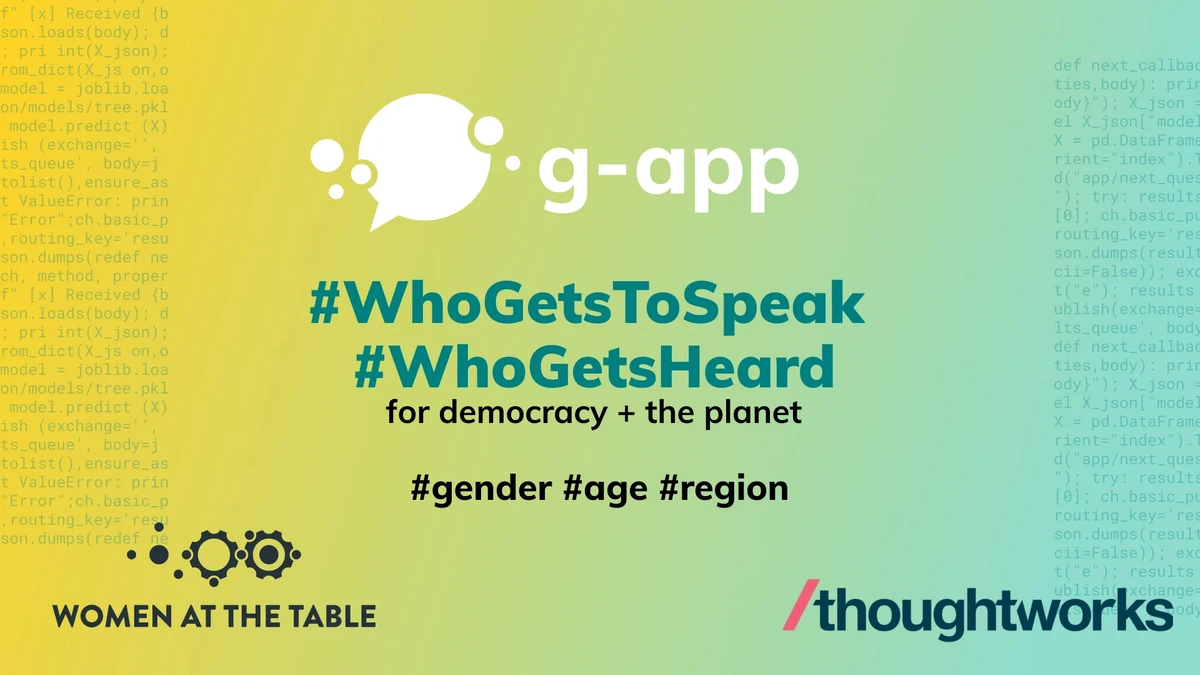Women@theTable and /ThoughtWorks was an official side event for the ECOSOC Partnership Forum on 2 February 2022. They presented on The Deadly Data Gap: Gender, Age, Region #WhoGetsToSpeak #WhoGetsHeard

Background:
Who Gets to Speak on behalf of a changing world in crisis? At this critical moment in history, we see the stark divisions on who helps make the decisions that will affect generations to come. Speakers Hon. Patricia Torsney, Permanent Observer – Head of the New York Office, Office of the Permanent Observer of the Inter-Parliamentary Union (IPU) to the United Nations; Satish Viswanathan, Thoughtworks, Head of Social Impact, India; and Moderator, Caitlin Kraft-Buchman, Women@theTable CEO/Founder shared the newly developed open-source g-app software designed to measure the active participation of women and youth in international conferences – capturing the proportion of time, the topics, the capacity and delegated authority women and youth speak in the conference chamber. The data is captured in order to provide concrete metrics to evaluate representation, participation and influence. It is critical to highlight these figures in order to catalyze the outcome of more women and youth in leading positions corresponding to their proportion in the population.
Watch the Full Video
Key Issues discussed
- Why is it important to be quantitative about ‘Who gets to speak & heard?’ Organizations such as IPU, and UNFCCC have been tracking gender composition as mandated by governing bodies over the past 5-10 years and have tried to move past counting the numbers of women to counting the influence of women and youth in the conference chamber. The g-app was born out of the need to not only count numbers attending international events but to analyze who is speaking, with which authority, and on which topics. p.ex, the 2021 UNFCCC/COP-25 gender report showed 74% of speaking time in plenary was taken by men.
- The g-app technology easily analyzes and graphically represents data on the active participation, representation, and influence of women and youth at conference events. It measures: Who is in the room? Do they have the power to speak? Or do they only speak on certain topics that are directly related to their demographics?
- Gender parity via attendance at a conference does not translate into who is speaking and who has influence. The use of proxies such as Head of Delegation identify who has the most influence. p.ex, the 2022 WHO Executive Board had only 9% female Heads of Delegation (a backwards trend) Consequently, in 2022 91% males made decisions for post-pandemic global health, (despite the global health workforce being 70% female).
- We cannot have women or youth speaking only on “gender or youth day”. We need them to speak on climate, the economy and other crucial issues affecting us all. With only one set of voices, we will not have the breadth and depth of innovative solutions we need to solve our increasingly pressing issues.
- Data matters! When you are able to collect and visualise what the data means it is much better than saying “We need more of” or “We should do better”. Instead, we are able to track the progress of what creates successes, or failures, and learn.
- You can’t make changes unless you have all the data. The g-app is one of the first steps in truly understanding where we are at currently and where we need to go to accomplish our goals.
- The g-app software architecture functions by collecting
- Topics: the organizers determine from their official agenda
- Conference Demographics: anonymized conference data Registration ID, Gender, Organization Type, Country, Conference Role, Age)
- Video/Audio Recording: downloaded proceedings for each session.
- Speaker Order: keyed to anonymized Conference Demographics
- The g-app then produces graphics reports on
- Gender & Age Distribution of women and youth who registered in proportion to how much time they spoke at the conference
- Gender (and Age) Distribution by Region
- Gender (and Age) Distribution by Conference Roles p.ex, Head of Delegation or Delegate
- Gender (and Age) Speaking Time by Session Roles (p.ex, Chair, Panelist, Delegate)
- Gender (and Age) Speaking Time by Topic (determined by the explainable algorithm created for this project.
Key recommendations for action
- Institutionalize monitoring of and reporting on women and youth representation, participation and influence in official UN processes.
- Gender composition reports have been strengthened by adding data on age and gender and how they intersect in relation to Party delegates and heads and deputy heads of delegation.
- The persistent lack of progress in and the urgent need for improving the representation of women and youth in Party delegations and constituted bodies has been recognized in that the full, meaningful and equal participation and leadership of women and youth in all aspects of UN processes is vital for achieving the Sustainable Development Goals.
- The open-source (and free) g-app software premiered at the Paris Peace Forum 2021, and could be used throughout the UN System and beyond to accomplish and document the aims of true representation, participation and influence of women and youth in achieving the Sustainable Development Goals. A longitudinal study is also planned for the data.

